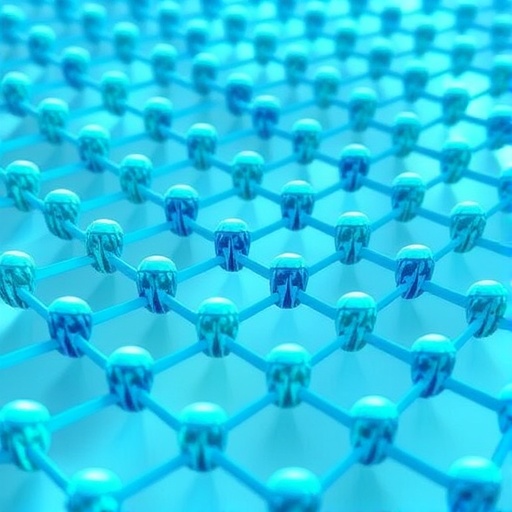In recent advancements within the field of energy storage, the development of sodium-ion batteries (SIBs) has garnered significant attention as a potential alternative to lithium-ion batteries. This shift is fueled by the abundant availability and lower cost of sodium compared to lithium, making it a more sustainable choice for large-scale energy storage applications. The latest research led by Wang, C., Zhang, Q., and Zhang, Y. has introduced a novel anode material designed specifically for high-performance sodium-ion batteries: Zn₃P₂@C nanosheets. This innovative approach promises to enhance the efficiency and longevity of sodium-ion batteries, pushing the boundaries of current energy storage technologies.
The underpinning technology of Zn₃P₂@C nanosheets lies in their unique structure and composition, which combine the favorable electrochemical properties of zinc phosphide with the conductive advantages of carbon-based materials. Zinc phosphide has exhibited excellent capacity retention and cycling stability, qualities that are crucial for the sustained functionality of battery electrodes. By encapsulating Zn₃P₂ within carbon nanosheets, researchers aim to address issues related to conductivity and structural integrity during charge and discharge cycles, which have historically hindered the performance of sodium-ion batteries.
One of the notable advantages of using Zn₃P₂@C nanosheets is their ability to form a stable solid electrolyte interface (SEI). This SEI layer is critical for the longevity of battery performance as it prevents the loss of active material and mitigates side reactions that can degrade battery capacity over time. In contrast to traditional anode materials, the inherent qualities of Zn₃P₂@C allow for a more robust and conductive interface, resulting in improved efficiency during electrochemical reactions.
Moreover, the self-supported nature of these nanosheets signifies a major advancement in battery design. Traditional electrode configurations often rely on cumbersome binders, which can add weight and reduce the overall energy density of the battery. The self-supported characteristic of Zn₃P₂@C enables a more streamlined assembly and the potential for higher energy density, which is a key factor in optimizing battery performance for applications in electric vehicles and renewable energy storage systems.
Upon rigorous testing in various electrochemical environments, the Zn₃P₂@C nanosheets have displayed remarkable cycling stability, with researchers noting a minimal capacity fade even after extended charge-discharge cycles. The favorable electrochemical metrics achieved, including high rate capability and significant charge retention, position Zn₃P₂@C as a competitive alternative to mainstream anode materials like graphite and silicon.
The synthesis of Zn₃P₂@C nanosheets is a crucial aspect of their performance. Employing advanced fabrication techniques ensures uniformity in size and morphology, which are essential for achieving consistent electrochemical performance. By optimizing the synthesis process, the researchers have succeeded in producing high-quality nanosheets that maintain their structural integrity under operational stresses, leading to enhanced battery reliability.
Additionally, the environmental implications of this research cannot be overstated. By utilizing materials that are abundant in nature and non-toxic, the employment of Zn₃P₂@C addresses the pressing concerns around resource scarcity and ecological impact commonly associated with traditional lithium-ion technologies. This aligns with global endeavors to promote sustainable energy storage solutions in the face of growing environmental challenges.
Encouraged by the promising results from initial laboratory tests, the research team is now exploring scalability options for the Zn₃P₂@C nanosheets. The transition from laboratory-scale production to large-scale manufacturing is critical in determining the practical applicability of the technology in commercial batteries. Partnerships with manufacturers and energy corporations may be essential in bridging the gap between research and real-world application, helping to drive advancements in the sector.
The announcement about Zn₃P₂@C nanosheets coincides with a broader trend towards refining battery technology for enhanced performance. Industry players are investing heavily in research and development to identify next-generation materials that can surpass the limitations of existing technologies. The findings by Wang et al. are positioned as a potential breakthrough in this competitive landscape, highlighting the role of innovative materials in shaping the future of energy storage.
In conclusion, the exploration of Zn₃P₂@C nanosheets serves as a beacon of hope for the future of sodium-ion batteries. With their high-performance attributes, environmentally friendly profile, and self-supported design, these innovative anodes have the potential to redefine energy storage solutions. As our reliance on renewable energy sources grows, so too will the demand for efficient, sustainable battery technologies. This research stands at the forefront of this crucial transition, promising a new era of energy storage that prioritizes both performance and sustainability.
The significance of this research emphasizes the continuous need for innovation in energy storage technologies. As the search for effective alternatives to lithium-ion batteries intensifies, findings such as those presented by Wang and colleagues provide a vital glimpse into what the future of energy could look like. With ongoing support from the scientific community and industry stakeholders, the transition to sodium-ion batteries could soon become a reality, heralding a new chapter in sustainable energy storage solutions.
Through further advancement and refinement of Zn₃P₂@C nanosheets, researchers aim to iterate on this promising technology. Continuous assessments will take place, with a focus on optimizing performance under various operational conditions. This proactive approach will ultimately determine the viability of sodium-ion batteries as a mainstream energy solution.
As the global energy landscape shifts towards sustainability, the role of research in battery technology cannot be overstated. Innovations like Zn₃P₂@C nanosheets are essential to achieving the goal of efficient and sustainable energy solutions, and one can only anticipate the exciting developments that lie ahead. This research not only contributes significantly to the scientific community but also serves as a critical stepping stone to a greener and more sustainable future.
Subject of Research: Nanosheet-based anodes for sodium-ion batteries
Article Title: Zn₃P₂@C nanosheets as self-supported anodes for high-performance sodium-ion batteries
Article References: Wang, C., Zhang, Q., Zhang, Y. et al. Zn₃P₂@C nanosheets as self-supported anodes for high-performance sodium-ion batteries. Ionics (2025). https://doi.org/10.1007/s11581-025-06569-7
Image Credits: AI Generated
DOI: https://doi.org/10.1007/s11581-025-06569-7
Keywords: sodium-ion batteries, Zn₃P₂@C, energy storage, electrochemical performance, sustainability




